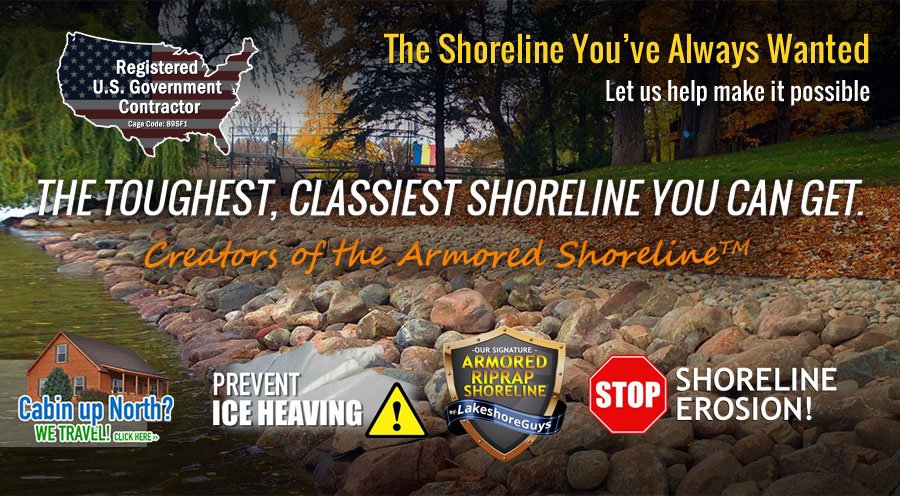Can You Have a Winter Without Ice Jacking?
No. There are bad conditions, and there are worse conditions. Ice jacking is a fact of nature. The (somewhat) good news is that by knowing a little about how ice jacking works, you can predict with some accuracy how bad the ice jacking will be this year.
Key principle
A key principle to understand is that a frozen sheet of ice that’s expanding towards the shoreline can only do one of two things: It can either slide up the slope of the shoreline, OR it can plow right through and into the shoreline, creating a giant mound of soil – an ice ridge.
Please remember that point. It’s an important one.
Bad conditions (a normal winter)
Conditions are ripe for ice jacking whenever a normal to-average winter season is upon us.
But conditions won’t be as bad if you have a lot of snow cover. Yep, no matter how much you may like a mild winter, it’s usually terrible for your shoreline.
You want an average-to-thick blanket of snow to insulate the ice from the sun’s rays and warmer daytime temperatures.
You also want normal to below normal temps causing the frost within the ground to travel several feet in depth, turning your shoreline into a rock solid ramp of frozen soil.
Normal-to-average winters are bad, but that’s only because “bad” is as good as it gets when it comes to shorelines, ice jacking, and the mess they leave behind (particularly ice ridges).
Worse conditions (a mild winter)
A mild winter is still winter. The lake will still freeze. Only now, the problem is about to compound.
First, the ground (i.e. your shoreline) isn’t going to freeze as deeply as it would if it were a much colder winter. When frost doesn’t penetrate the ground several feet in depth, it leaves your shoreline a weakened state, because frozen soil is harder than thawed soil. Also, in a milder winter the snow is not insulating the ground from the sun’s rays, either, so the sun keeps the soil in your shoreline toasty. That’s the opposite of what you want.
Meanwhile, the sun beats down directly on the ice, too. There’s no snow to offer the ice any kind of insulation or protection from the sun. So as the ice warms, inch by inch the ice sheet expands, jacking outward and pushing up the banks of the mushy shoreline. Because the shoreline is softer than usual, it’s easier for the ever-expanding sheet of ice to plow through your shoreline, rather than slide up it.
Frozen soil isn’t fun to play sports on, but it helps keep your shoreline intact.
Fluctuating temperatures
Warm, mild winters are known for wildly fluctuating temperatures. Nighttime lows are usually still mighty cold. When I refer to a winter as “mild,” I’m usually referring to the daytime highs.
As these warmer daytime highs clash with the plummeting nighttime lows, the giant frozen sheet of ice expands and contracts even more. The problem is those cracks in the ice – caused by expansion – freeze solid before the ice has a chance to contract again. So, instead of “expand, contract, expand, contract,” what you end up with is “expand, expand, expand.” That’s not good for Mr. Shoreline, especially one that’s not been battle-hardened by a cold winter.
But Lakeshore Guys® can’t stop ice jacking, right?
Right. Ice jacking is a natural phenomenon.
(If we could control natural phenomena, we’d probably forget all about ice jacking. We’d sell nice weather to England and make a bloody fortune.)
What we can do is make sure your shoreline is properly sloped and riprapped so that the ice sheet is more likely to slide up the slope of your shoreline rather than bulldoze through it. See a real-life example (with a video and photos) here, or contact Lakeshore Guys® today.



